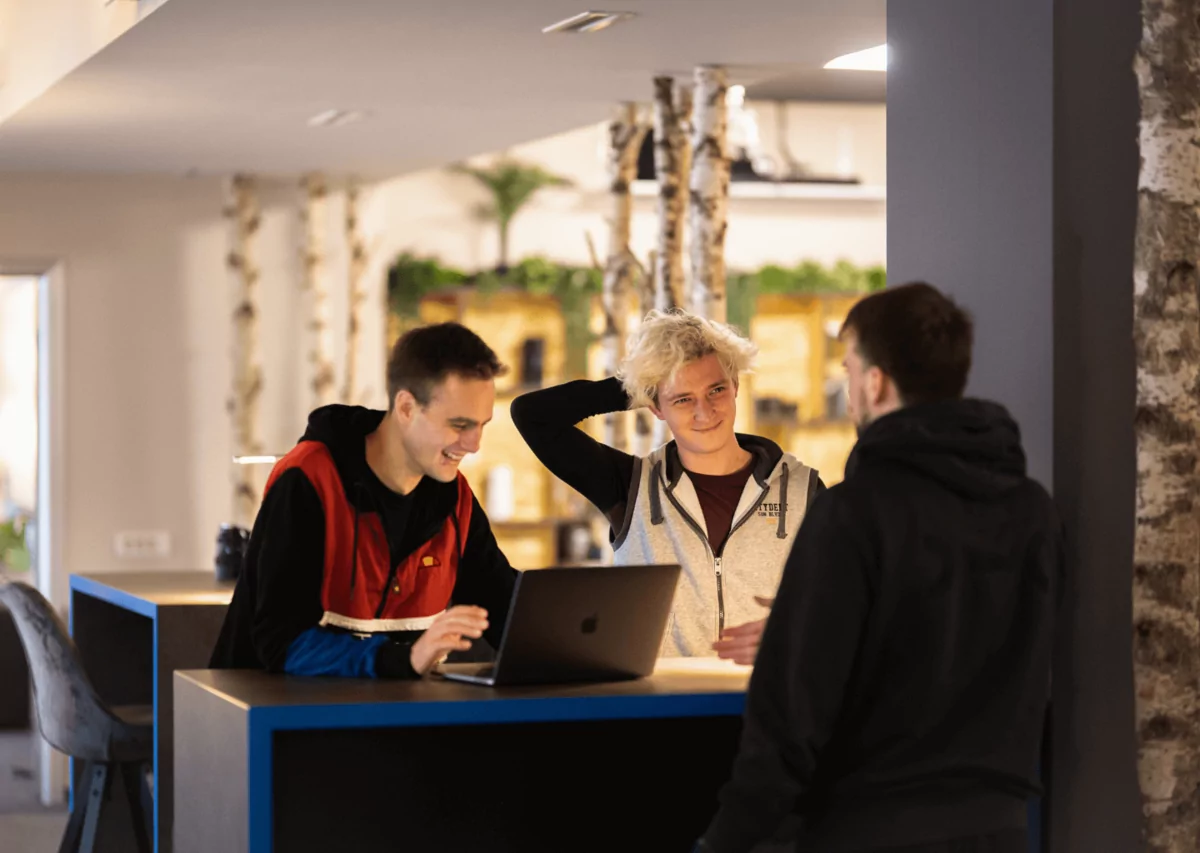Would you build a house without consulting with the builders and your family first?
Of course not.
You shouldn’t build a product without consulting with your team and stakeholders, either.
Kickoff meetings are a great way to get everyone on the same page before you start product discovery .
In this article, we bring you 8 key tips for a successful kickoff meeting in product discovery.
Let’s dive in!
To prepare for the kickoff meeting, you’ll need to do some preliminary research.
A good example of preliminary research is identifying and analyzing your target market.
Make sure you have the data ready before you start the kickoff meeting.
Some data points you have are:
Don’t worry, you don’t have to do full market research before the kickoff meeting – this is just the first step in the market research process .
It’s important you gather this information so your discovery team can make informed decisions during the meeting.
You should also prepare preliminary data about your target audience and your competitors .
At this stage, these will be your best assumptions and you’ll need to validate
However, they’ll provide your stakeholders with valuable context and shape the direction of your product discovery going forward.
You should also research which stakeholders you want to invite to the meeting.
Prioritize inviting key stakeholders relevant to your discovery process.
This core group of stakeholders should include your:
Product manager
Designers
Lead engineer
The client or the client’s representative
They’ll form your core discovery team
Don’t turn your kickoff meeting into a statistic.
Big organizations lose an estimated $100 million every year to unnecessary meetings.
Having an effective agenda will ensure your kickoff meeting remains focused and productive.
An agenda will provide you with a clear roadmap for discussion and inform the participants about the meeting’s goals.
You should share it with all the attendees well before the meeting begins so they can properly prepare for the meeting.
Here’s an example of how a kickoff meeting agenda might look like:
source: Vowel
Your agenda should cover all the main points you’ll be discussing during the meeting.
To reduce stress and keep everyone focused, include short breaks between each discussion.
It’s a good idea to include your best estimate on how much time will be spent on each point.
You should also assign someone to be the meeting’s facilitator, to moderate the discussion.
This’ll give your kickoff meeting structure and keep it on track.
However, this shouldn’t be set in stone.
Inevitably, some discussions will be shorter while others might go over the allotted time.
Don’t interrupt productive discussions if they go over the time limit or stick to a discussion point if the discussion is clearly over.
The kickoff meeting is the launching point of your product discovery process.
The first thing you should do during the meeting is set clear goals you want to achieve during discovery.
It’s impossible to build a successful product without clearly defined objectives.
If your team doesn’t know what they’re building towards, they won’t be able to build a product that meets your users’ needs.
That’s why it’s important that all stakeholders understand your discovery goals from the start.
A useful framework for setting goals is the SMART framework , pictured below:
Using this framework, you’ll be able to keep your discovery efforts focused.
You should also clarify the scope of your product discovery during the kickoff meeting.
You should inform your stakeholders about:
The discovery timeline
The phases of the discovery process
Deliverables from each phase
How this fits in your broader product strategy
This way, you’ll align everyone’s expectations going forward.
You’ll also avoid miscommunication and ensure your discovery goes smoothly.
Collaboration is a cornerstone of product discovery.
This should be clear from the very beginning of your product discovery process.
That’s why you should foster open communication during your kickoff meeting.
So, how can you make that happen?
The simplest way is employing the 3 Cs .
The key to a collaborative discussion is involving every participant.
Your facilitator should encourage everyone to engage in the discussion and ask questions.
That won’t happen unless everyone feels comfortable participating.
That’s why you should ensure that the meeting is a safe space where everyone can give their input without judgment.
Another good way to encourage collaborative discussion is planning group activities like brainstorming and ideation.
This way, you’ll ensure that you make decisions collectively and that everyone has a hand in making them.
It’s essential you define success metrics and set your key performance indicators (KPIs) during the kickoff meeting.
If you don’t have a way to measure your product’s success, can it ever truly be successful?
The answer is no, it can’t.
These metrics should be quantifiable and aligned with the goals you’ve set for your product.
Just like your discovery goals, your KPIs should follow the SMART framework, as pictured below:
source: Hubspot
Some common metrics you can track are:
User engagement
Customer satisfaction
Conversion rates
Defining these metrics will help your discovery team build a successful product.
Tracking them will help them prioritize features and make decisions on your product’s design.
Let’s say they’re doing A/B testing during UX research.
The feature or design with higher user engagement should be the one included in the minimum viable product (MVP).
Setting clear success metrics and KPIs during your kickoff meeting will maximize your product’s chances of success.
Setting a realistic timeline for your product discovery is essential to its success.
If it’s too short, you’ll overwork your team and they’ll make avoidable mistakes.
If it’s too long, they’ll end up with a lot of idle time that can be better spent doing other things.
You should discuss how long each discovery phase will take with your team and use their insights to create the discovery timeline.
Here’s an example of what it might look like:
source: Aktia Solutions
Keep in mind that your timeline should be flexible , though.
Make sure you leave enough breathing room so you can address any challenges and risks that crop up during discovery.
Let’s say your main competitor beats you to the punch and launches a product very similar to yours.
If that happens, your team will have to find a new way to position your product.
This will require extra research, brainstorming and ideation.
That becomes impossible if you’re keeping them to a strict timeline.
Having a flexible timeline will allow your team to address challenges like that without worrying about deadlines.
This’ll result in a smoother and more successful product discovery.
One of the main goals of your kickoff meeting should be to assign clear responsibilities.
Everyone on your discovery team should know exactly what they’re supposed to do during each discovery phase.
Start with assembling your core discovery team i.e. the product trio.
Here at DECODE, we use a similar approach and our key product discovery roles are:
Having an established discovery team like this makes assigning everyone’s responsibilities much easier.
Still, it’s a good idea to briefly discuss it during the kickoff meeting to avoid any confusion and foster transparency.
Depending on the complexity of your product, you might need to involve people outside of your core discovery team.
They might be:
Additional designers and engineers
Dedicated researchers
UX writers
Let your product trio take the lead and decide what they’ll be doing and who they’ll report to.
If everyone understands what they’re supposed to be doing, you’ll minimize disruptions and conflict within your discovery team.
It’s important to always document your kickoff meeting’s outcomes.
This is because our memory is a fickle thing.
Two people might remember the same event completely differently.
Documenting the outcomes of the meeting will help keep everyone on the same page.
App development starts with product discovery…
You should appoint a team member to take the meeting’s minutes and other important notes.
It’s also a good idea to recap the key takeaways at the end of the kickoff meeting and after each activity.
Once you’ve documented the meeting outcomes, distribute them to all participants.
They should cover all the key decisions made during the meeting, such as:
The discovery timeline
Every team member’s role and responsibilities
KPIs
Having a written record of the meeting will minimize confusion about its outcomes.
They can come in handy in other situations, too.
Let’s say your product designer suddenly gets sick, and you have to onboard another one in the middle of discovery.
Having a document summarizing the goals, KPIs, discovery timeline, and their new responsibilities will speed up the onboarding process.
And the end of the kickoff meeting is also a good time to schedule regular follow-up meetings with your discovery team.
Regularly keeping in touch with your discovery team will help keep your discovery process on track.
Holding a successful and productive kickoff meeting will help start your product discovery on the right foot.
It’ll also help get all stakeholders aligned with your product’s goals and vision.
So, what are the key tips for holding a successful kickoff meeting?
If you want to learn more about product discovery, check out our process or read our other articles on the topic.





